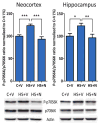AMPA receptor antagonist NBQX attenuates later-life epileptic seizures and autistic-like social deficits following neonatal seizures
- PMID: 24117347
- PMCID: PMC4262152
- DOI: 10.1111/epi.12378
AMPA receptor antagonist NBQX attenuates later-life epileptic seizures and autistic-like social deficits following neonatal seizures
Abstract
Purpose: To determine whether AMPA receptor (AMPAR) antagonist NBQX can prevent early mammalian target of rapamycin (mTOR) pathway activation and long-term sequelae following neonatal seizures in rats, including later-life spontaneous recurrent seizures, CA3 mossy fiber sprouting, and autistic-like social deficits.
Methods: Long-Evans rats experienced hypoxia-induced neonatal seizures (HS) at postnatal day (P)10. NBQX (20 mg/kg) was administered immediately following HS (every 12 h × 4 doses). Twelve hours post-HS, we assessed mTOR activation marker phosphorylated p70-S6 kinase (p-p70S6K) in hippocampus and cortex of vehicle (HS + V) or NBQX-treated post-HS rats (HS + N) versus littermate controls (C + V). Spontaneous seizure activity was compared between groups by epidural cortical electroencephalography (EEG) at P70-100. Aberrant mossy fiber sprouting was measured using Timm staining. Finally, we assessed behavior between P30 and P38.
Key findings: Postseizure NBQX treatment significantly attenuated seizure-induced increases in p-p70S6K in the hippocampus (p < 0.01) and cortex (p < 0.001). Although spontaneous recurrent seizures increased in adulthood in HS + V rats compared to controls (3.22 ± 1 seizures/h; p = 0.03), NBQX significantly attenuated later-life seizures (0.14 ± 0.1 seizures/h; p = 0.046). HS + N rats showed less aberrant mossy fiber sprouting (115 ± 8.0%) than vehicle-treated post-HS rats (174 ± 10%, p = 0.004), compared to controls (normalized to 100%). Finally, NBQX treatment prevented alterations in later-life social behavior; post-HS rats showed significantly decreased preference for a novel over a familiar rat (71.0 ± 12 s) compared to controls (99.0 ± 15.6 s; p < 0.01), whereas HS + N rats showed social novelty preference similar to controls (114.3 ± 14.1 s).
Significance: Brief NBQX administration during the 48 h postseizure in P10 Long-Evans rats suppresses transient mTOR pathway activation and attenuates spontaneous recurrent seizures, social preference deficits, and mossy fiber sprouting observed in vehicle-treated adult rats after early life seizures. These results suggest that acute AMPAR antagonist treatment during the latent period immediately following neonatal HS can modify seizure-induced activation of mTOR, reduce the frequency of later-life seizures, and protect against CA3 mossy fiber sprouting and autistic-like social deficits.
Keywords: AMPA receptor antagonists; Autistic-like behavior; Early life seizures; Epileptogenesis; Hypoxic/ischemic encephalopathy.
Wiley Periodicals, Inc. © 2013 International League Against Epilepsy.
Figures




References
-
- Amiet C, Gourfinkel-An I, Bouzamondo A, Tordjman S, Baulac M, Lechat P, Mottron L, Cohen D. Epilepsy in autism is associated with intellectual disability and gender: evidence from a meta-analysis. Biol Psychiatry. 2008;64:577–582. - PubMed
-
- Anderson AE, Hrachovy RA, Antalffy BA, Armstrong DL, Swann JW. A chronic focal epilepsy with mossy fiber sprouting follows recurrent seizures induced by intrahippocampal tetanus toxin injection in infant rats. Neuroscience. 1999;92(1):73–82. - PubMed
-
- Baulac M, Pitkanen A. Research Priorities in Epilepsy for the Next Decade-A Representative View of the European Scientific Community. Epilepsia. 2008;50:571–578.
Publication types
MeSH terms
Substances
Grants and funding
LinkOut - more resources
Full Text Sources
Other Literature Sources
Medical
Miscellaneous

